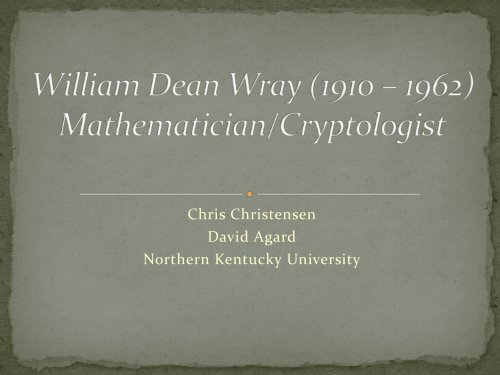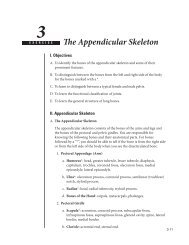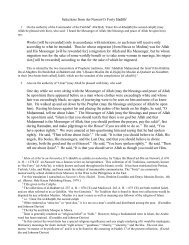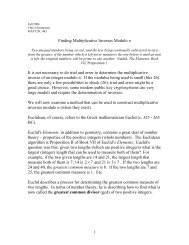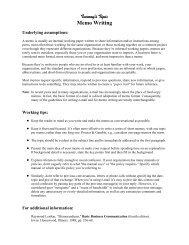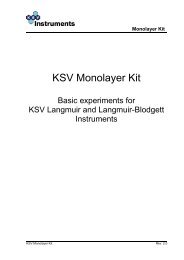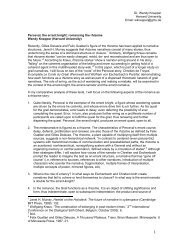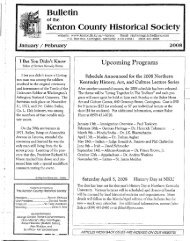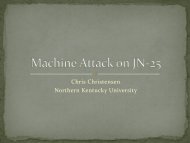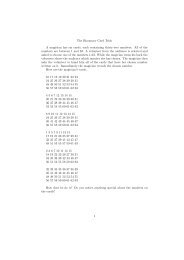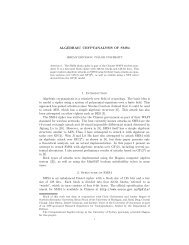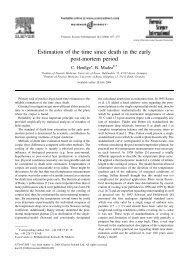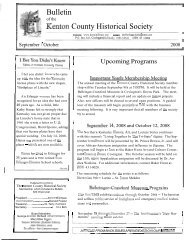William Dean Wray (1910 – 1962) Mathematician/Cryptologist
William Dean Wray (1910 – 1962) Mathematician/Cryptologist
William Dean Wray (1910 – 1962) Mathematician/Cryptologist
Create successful ePaper yourself
Turn your PDF publications into a flip-book with our unique Google optimized e-Paper software.
Chris Christensen<br />
David Agard<br />
Northern Kentucky University
Two days after <strong>William</strong>’s 6 th birthday, a fire engine<br />
came to the <strong>Wray</strong> home to take <strong>William</strong> to the<br />
hospital. During the summer there had been a polio<br />
outbreak in New York City, and despite efforts by<br />
health department authorities that outbreak had<br />
spread to upstate New York. He was taken to the<br />
former Henry Sage mansion that had been the<br />
infirmary for Cornell University. An annex had<br />
become an isolation ward for polio patients.
“[<strong>William</strong>’s] days of normal boyhood development<br />
were over.” “During the winter of 1916 <strong>–</strong> 17, while the<br />
United States inched its way toward war with German,<br />
Alfred and Sarah worked to restore <strong>William</strong> to as<br />
nearly a normal life as he would ever be able to have.<br />
The life of the family was accommodated to the<br />
routine of his exercise and rest periods. He did not go<br />
to school, but his mother taught him at home.”<br />
“His bed was an iron frame, and on it he was<br />
immobilized by straps across his chest and abdomen.”
“<strong>William</strong> spent the summer [of<br />
1925] swimming in the warm and<br />
buoyant waters at Warm Springs<br />
and loved every minute of it.”<br />
“A high point of the summer for<br />
<strong>William</strong> was meeting Franklin<br />
Roosevelt. <strong>William</strong> had several<br />
conversations with Mr.<br />
Roosevelt, who was something<br />
of a hero to <strong>William</strong> because of<br />
his valiant battle against polio<br />
and his refusal to be defeated by<br />
his handicaps. One day the<br />
future President presented<br />
<strong>William</strong> with his old Chemistry<br />
book. <strong>William</strong> would cherish<br />
this gift throughout his life.”
Haverford College<br />
<strong>William</strong> entered the small,<br />
Quaker-founded, liberal<br />
arts Haverford College<br />
located west of<br />
Philadelphia to prepare for<br />
a career as a teacher.<br />
<strong>William</strong> was a<br />
mathematics major.<br />
“<strong>William</strong>’s course grades<br />
were never outstanding<br />
Graduated with A.B. in<br />
1932.<br />
Cornell<br />
February 1941 Ph. D. Cornell. “Some<br />
Applications of Uniformity Trials.”<br />
July 1934, to January 1938 Teacher of<br />
Mathematics at Cascadilla School,<br />
Ithaca, NY.<br />
September 1937 to June 1940<br />
Instructor of Mathematics at<br />
Cornell University, Ithaca, NY.<br />
January 1938 to June 1942 Instructor<br />
of Mathematics at <strong>William</strong>s College,<br />
<strong>William</strong>stown, MA .<br />
Naval “Elementary Cryptanalysis”<br />
correspondence course while at<br />
<strong>William</strong>s College
… during the late 30’s and early 40’s the Navy had made a<br />
rather timely assessment of the rising exigency and set up<br />
an extensive and effective recruitment program to cinch up<br />
the capabilities of the Reserves. … the all-out recruitment<br />
program was a major factor in beefing up our intelligence<br />
capability. Following the canvas of major colleges<br />
throughout the country as well as personnel of the Naval<br />
Reserve itself, the “correspondence course” was made<br />
available to a number of people on a highly selective basis.<br />
This energetic program clearly proved its merit when the<br />
war broke out and the Navy was able to come up with a<br />
cadre of highly professional people who were immediately<br />
available to become active as commissioned officers of the<br />
Navy.<br />
Paul Kosatka
Admittedly, in the summer of 1942, Bill and I as civilians<br />
were low men on the totem pole. … Our supervisor had<br />
been an Associate Professor of Mathematics at Yale<br />
University. Three others of the uniformed staff were Yale<br />
people and these three were well-known to our supervisor<br />
and had better mathematical reputations then we had.<br />
Although Bill and I had degrees from Cornell and<br />
Princeton, respectively. Bill had come to the Navy from a<br />
small Massachusetts school and I came from faraway Texas.<br />
But, in about a year’s time, Bill and I working together<br />
solved a problem that these others had tried their hand on<br />
and had not been able to solve. From then on we had a<br />
reputation.
You can imagine my surprise when I had asked for<br />
some professional mathematical talent and in the<br />
same week in walked two weird characters. One was a<br />
person of short deformed stature, one was a long lean<br />
lanky character. Both looked ill-fed and it didn’t look<br />
like either of them would ever have a good<br />
mathematical idea.<br />
Howard Engstrom
Nebraska Avenue<br />
OP-20-G<br />
Top row<br />
4: Greenwood<br />
5: Engstrom<br />
9: Tiltman<br />
Middle row<br />
2: Hall<br />
5: Gleason
Bill soon became a favorite of<br />
the entire staff, both officers<br />
and enlisted personnel. A<br />
naval directive required that<br />
all naval officers be addressed<br />
as Mr. ______. The enlisted<br />
personnel did not fancy being<br />
ordered how to address<br />
others. Here, in Bill <strong>Wray</strong>,<br />
was a person whom they did<br />
not have to call “mister”. So,<br />
with genuine affection, they<br />
called him Doctor <strong>Wray</strong>.<br />
Robert Greenwood
I am not sure what details of that period of cryptology<br />
were ever declassified, but … I do know that Dr. <strong>Wray</strong><br />
played a significant role in running the major analytic<br />
organization supporting U.S. policy and diplomatic<br />
activities surrounding [the Marshall Plan and the<br />
stand-up of NATO].<br />
George Cotter
Korea<br />
[<strong>Wray</strong>’s organization] was<br />
very deeply and directly<br />
engaged in supporting our<br />
forces on the Korean<br />
Peninsula. I know few<br />
details but Dr. <strong>Wray</strong> was<br />
clearly a force in the<br />
elevation of AFSA to the<br />
National Security Agency, a<br />
step that occurred in 1952.<br />
George Cotter
October, 1952, <strong>Wray</strong><br />
transferred to the newly<br />
created national Security<br />
Agency.
Employee Performance Appraisal 1956<br />
As Chief of a division containing almost 1000 civilian<br />
and Service personnel Dr. <strong>Wray</strong> continues to do an<br />
excellent job. … He has my full confidence and I place<br />
him among the few whom I would consider key<br />
personnel in the National COMINT Center.<br />
/s/ Louis W. Tordella, Chief, NSA-70
1956 Chief of ACOM.<br />
1959 Chief of Production Group C. Techniques Group.
During the first half of the period of this appraisal, [<strong>Wray</strong>]<br />
was Chief of the Techniques Group, a staff organization of<br />
PROD responsible for assisting all areas requiring technical<br />
assistance, and for dealing with those technical matters not<br />
the purview of any single analytic office.<br />
Dr. <strong>Wray</strong> was taken from this assignment to serve on a<br />
specially appointed Management Board whose mission was<br />
to study the reorganization of the Agency.<br />
In this new structure, Dr. <strong>Wray</strong> has assumed the position of<br />
Chief of Group C which provides all the necessary technical<br />
services for the analytic areas.<br />
/s/ John J. Davis, BRIG GEN, USA, ADP
It is therefore difficult to pinpoint the exact nature or<br />
extent of his personal involvement in NSA’s actions<br />
during [the Cuban Missile Crisis]. Nevertheless,<br />
CINCLANT’s 28 November letter to Lt. General<br />
Gordon Blake, then Director of NSA, would seem to<br />
include Dr. <strong>Wray</strong> in the assessment that “In the<br />
present situation SIGINT has been one of the most<br />
important single factors in supporting our operations<br />
and improving our readiness” during the crisis.
He was off work about two or three weeks and when he came<br />
back he was under Doctor’s orders to work only four hours a day.<br />
This he did for a little over a week and then the Cuban missile<br />
crisis flared up and our Agency was heavily involved. The<br />
organization Bill was directing at the time was responsible for<br />
this area. … Bill quickly forgot his doctors orders and started<br />
putting in long days. We all put in extra hours and I can<br />
remember going home after a 12 or 14 hour day and seeing Bill<br />
still around the area. I know that at least on one occasion he<br />
didn’t go home at all but managed to get a little rest on a bed in<br />
the dispensary. Just as the Cuban missile crisis came to an end<br />
Bill went into his terminal illness and shortly thereafter passed<br />
away. There is no question in my mind that Bill sacrificed his life<br />
for his country.<br />
John Guccione
[Dr. <strong>William</strong> <strong>Wray</strong>] devoted much of the latter part of<br />
his career to improvements in NSA management, and<br />
he was universally respected for his insight into<br />
technical needs. He was successively Deputy Chief of<br />
TNG, Chief of ACOM, Chief of PROD 03, Chief of C<br />
Group, and finally Chief of B Group. … he was also, at<br />
the time of his death, president of the Crypto-<br />
Mathematics Institute.
Dr. <strong>Wray</strong> was a brilliant and eminently successful<br />
leader in the field of Cryptology, and is deserving of<br />
this highest Civilian Service Award.<br />
/s/ John J. Davis, Major General, USA, Assistant<br />
Director, NSA for Production


